Background
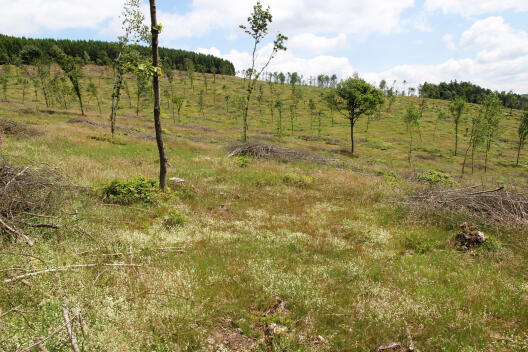
© Uni MS - Johannes Kamp The biodiversity of open landscapes has been declining strongly over the past decades in Central Europe. Agricultural intensification and farmland abandonment are the most important drivers of this trend. Changes in forest management are now surfacing as an additional cause: a transition from light, open forests to tall, dense stands with a cooler microclimate has resulted in losses of many open-habitat plants and animals during the past decades.
Open-country biodiversity in Central Europe often survives in cultural landscapes, managed as socio-ecological systems. With decade-long trends of urbanization, rural outmigration and a loss of traditional knowledge, important components of such systems have been lost. However, landscapes still exist where traditional land management results in large biodiversity benefits. An example for such langscapes are traditionally managed coppiced woods.
In Northern Hesse, in the Lahn-Dill-area, a contiguous area of 1,800 ha oak-birch-forest is coppiced by village communities in a very traditional way, nowadays mostly for firewood. Stands are cut down patchily after 18-20 years, which results in a rich mosaic of forest regrowth of young age classes (picture gallery).
Our main aims in this project are:
- To quantify the area of managed coppice during the past 200 years using historical maps
- To relate bird and butterfly abundance to habitat quality, habitat patch size and isolation in order to quantify important factors driving the survival of open-forest species
- To reconstruct bird population trends for the past 200 years by back-projecting population densities to historic landscapes
- Based on the collected data, to develop scenarios of future land use assuming coppice persistence and coppice loss, and assessing trade-offs between biodiversity, economical viability and societal persistence of coppice systems.

© Uni MS - Johannes Kamp 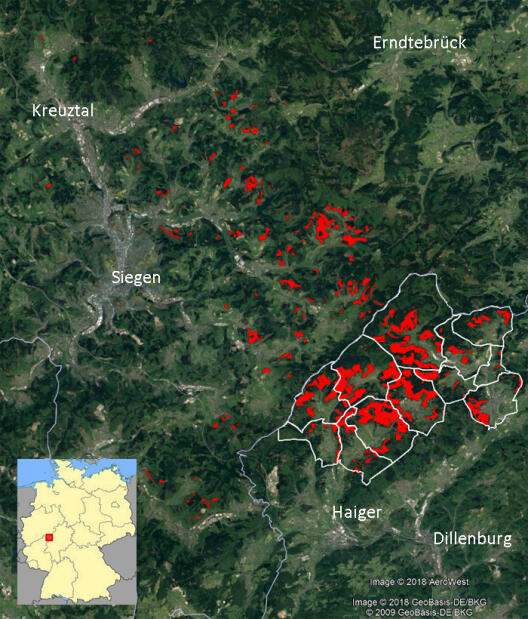
Study area and its location in Germany (inset). Active coppice is marked red.© Uni MS - Johannes Kamp Study area
We focus on the coppiced woods (‘Hauberge’) of the Lahn-Dill-area (Northern Hesse), in the districts of Haiger and Dietzhölztal. Here, 1,800 ha oak-birch-forest are managed by local village communities – probably the last remaining large-scale coppice-without-standards woods in Central Europe where coppice cycles remained uninterrupted for the past 500 years.
Another estimated 10,000 ha of coppice exist in neighbouring Northrhine-Westfalia, but these stands are often aged and fragmented, and coppice cycles disrupted.Approaches
We are using historical maps, forestry data and aerial images to reconstruct the proportion of village catchments and the wider landscape covered by coppiced woods, old beech woods and spruce plantations for the period 1819 to 2017. We are also evaluating spatially explicit trends in the substitution of coppice by spruce plantations.
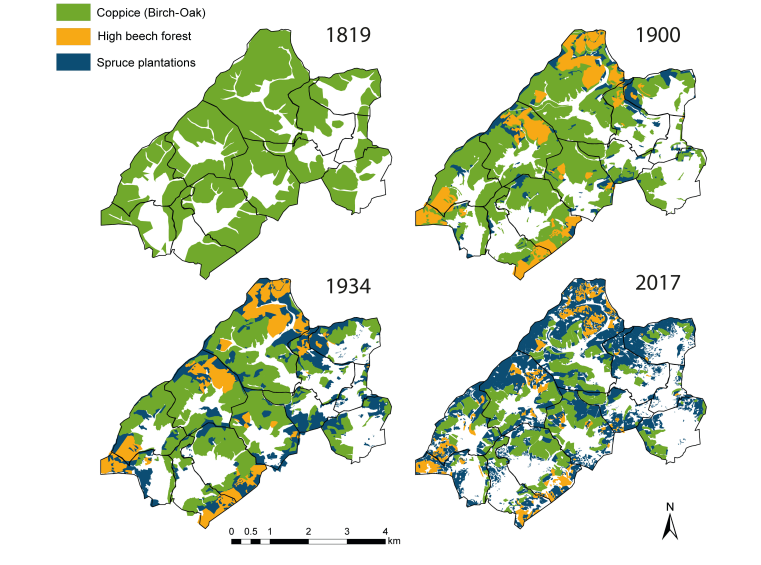
Forest management change in the study area (districts of Haiger and Dietzhölztal, N Hesse) since around 1819. Coppiced stands have been transformed into spruce plantations on a large scale, and to to high beech forests a lesser extent. In 2018, ca. 1,800 ha of actively managed coppice remains in the area.© Johannes Kamp 
With an estimated population of several thousand individuals in 2018, the study area is one of the last remaining strongholds of Ilex Hairstreak (Satyrium ilicis, right) in Central Europe. It also harbours large populations of many Scarce Copper (Lycaena virgaureae, left) and Heath Fritillary (Lycaena athalia).© Uni MS - Johannes Kamp We have been collecting biodiversity data in the field annually since 2016. Currently, we focus on birds and butterflies. We apply a robust sampling design and conduct point and line transect counts across all forest types on ca.180 plots, repeated five times per season.
For analysis, we use a novel approach to estimate animal abundance from our data, hierarchical distance sampling. This allows us to model the abundance of birds and butterflies as a function of forest stand age and habitat parameters, hereby uncovering abundance responses of the species to forest regrowth through the coppice cycle. The statistical approach allows us to correct our data for detectability, which varies across species and habitats, and availability (the likelihood of a species being available for detection, which varies e.g. with time of day or weather that affects activity).
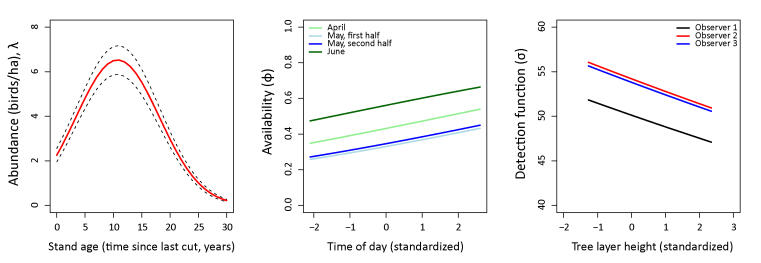
Results of a hierarchical distance sampling model. Left panel: The estimated abundance for Willow Warbler (Phylloscopus trochilus, sg. males per ha) that varies with times since last forest cut – very high densities are reached in medium-aged coppice. Central panel: Availability of Willow Warbler for detection clearly varies over the season and increases from sunrise to midday. Right panel: Detection probability varies with observer and decreases with increasing tree height.© Uni MS - Johannes Kamp Partners
Coordination
Johannes Kamp, Josef Kallmayer and Julian Koch
Collaborators
Walter Veit, NABU Kreisverband Lahn-Dill
Harro Schäfer, Heimatverein Offdilln
© DOG Funding
Parts of the project are funded by a Hans-Löhrl-Award of the German Ornithologists Society (DO-G) to Johannes Kamp.
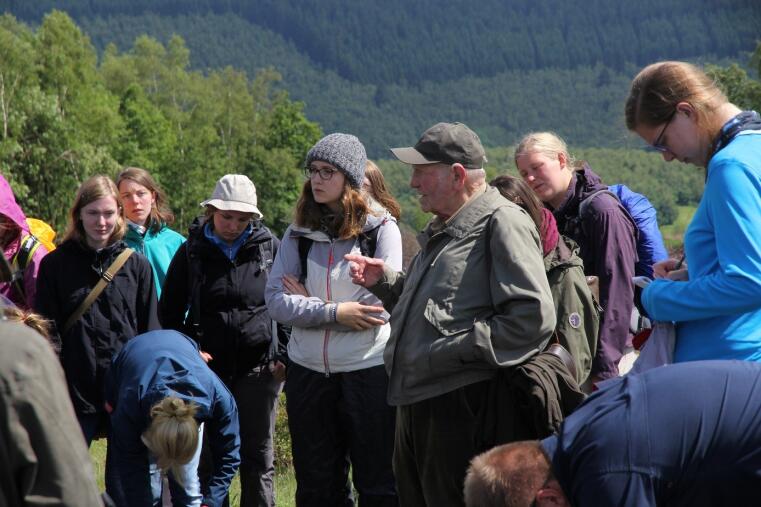
A local stakeholder explains coppice rotation cycles to Landscape Ecology students from Münster.© Uni MS - Johannes Kamp 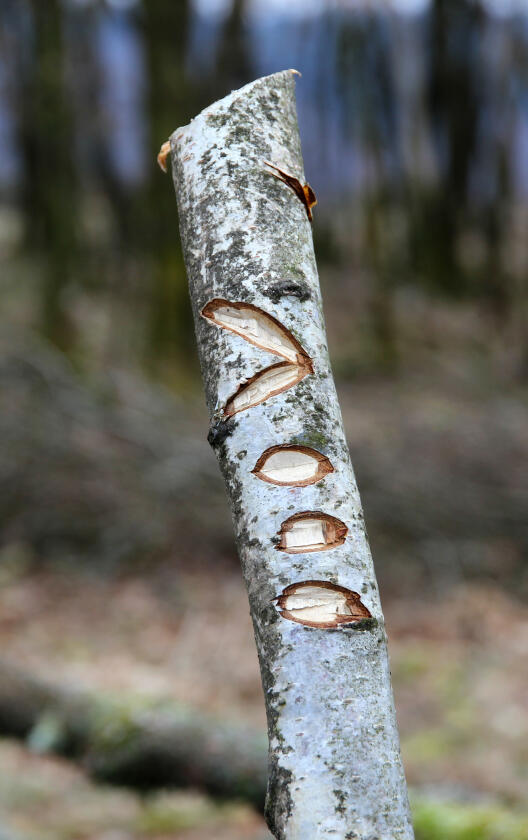
Personal ax-marks delimit the coppice shares, which a drawn anew every year – there are no owners, but only communal area use.© Uni MS - Johannes Kamp Info
Pictures
An annotated picture gallery of the area.
Finished theses (in German)
- Kallmayer, Josef (2016) The importance of coppiced oak-birch-woods for bird communities in Hesse, Germany. Bachelor thesis, Institute of Landscape Ecology, University of Münster
- Koch, Julian (2016) Population estimates for breeding birds of coppiced woods in Hesse, Germany. Bachelor thesis, Institute of Landscape Ecology, University of Münster
Running theses (in German)
- Graser, Anne & Schulz, Meike: The effects of habitat quality, patch size and patch isolation on the abundance butterflies of large coppiced forests. 2 Master theses, Institute of Landscape Ecology, University of Münster.
CopWoods
The biodiversity of traditional socio-ecological systems: Large coppiced woods in Germany


